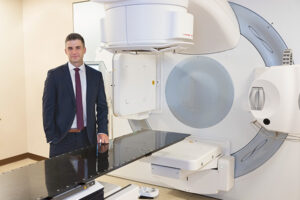Esophageal and Gastric Cancer Treatment Options
Radiation therapy is proven effective.
At MRO, we use radiation, aka radiotherapy, to destroy cancer cells, which are more susceptible to radiation than normal cells. Using state-of-the-art imaging techniques such as MRI, CT, and PET, your MRO care team can pinpoint radiation doses down to the millimeter.
For esophageal cancer, radiation may be used for several reasons:
- Radiation therapy is often given in conjunction with chemotherapy. Chemotherapy and radiation therapy administered together before surgery is a standard curative intent treatment for non-metastatic (localized) esophageal cancer.
- When given before surgery to try to shrink the cancer and make it easier to remove. Chemoradiation is called neoadjuvant treatment.
- Sometimes surgery may not be necessary if a complete clinical response is achieved. Instead, close surveillance may be pursued.
- If chemotherapy/radiation are required after surgery, to try to kill any cancer cells that may have been left behind but are too small to see, this is known as adjuvant therapy.
- When delivered to ease the symptoms of advanced (metastatic aka stage IV) esophageal cancer such as pain, bleeding, or trouble swallowing, radiation called palliative therapy.
 There are several different techniques used in esophageal cancer treatment, to direct precise doses of radiation at visible tumor and/or areas of suspected cancer cells. The machine used is called a linear accelerator (LINAC). Like an x-ray, radiation therapy is painless.
There are several different techniques used in esophageal cancer treatment, to direct precise doses of radiation at visible tumor and/or areas of suspected cancer cells. The machine used is called a linear accelerator (LINAC). Like an x-ray, radiation therapy is painless.
External-beam radiation therapy (EBRT) is the type of radiation therapy used most often for people with esophageal cancer. Your own treatment will depend on the type of tumor you have, where it’s located, and what type of technology we’ll be using.
Your doctor may use IGRT, image guided radiotherapy, where a CT is obtained daily for alignment purposes and/or IMRT/VMAT. Intensity modulated radiotherapy and a subtype of this called volumetric arc therapy are advanced methods of finely sculpting radiation dose to the tumor while avoiding surrounding normal tissues.
My goal is to provide the best treatment possible for each of my patients using state-of-the-art technology combined with personal care and attention. I aim to treat each of my patients as if they were a family member, by informing and supporting them throughout their treatment and beyond.”
Kurt Nisi, MD
MRO | North Memorial
For gastric cancer, radiation can be used in different ways:
- After surgery, radiation therapy can be used along with chemo to try to kill any cancer cells that weren’t removed during the surgery. This may help delay or prevent recurrence of the cancer.
- For cancers that can’t be removed by surgery, radiation therapy can sometimes be used to help slow the growth of the cancer and ease symptoms, such as pain, bleeding, or eating problems.
Once your MRO radiation oncologist has examined you, he or she will discuss treatment options and the pros and cons of radiation treatment, explain treatment, discuss how often radiation therapy is given, and provide information on how to take care of yourself during treatment.
“Radiation Oncology is my passion, as is helping others. I have a multi-cultural background and I understand how differently diverse cultural groups approach a cancer diagnosis. My goal is to provide the best, most compassionate care, in a way that’s appropriate to my patients’ needs.”
Raul Fernandez-Gonzalez, MD
MRO | Fairview Ridges
Since radiation therapy for cancer requires the utmost precision, you’ll also go through a simulation at the MRO Therapy Center. Using image mapping as a guide, your care team will position you as you would be for treatment and take measurements to build a targeted treatment plan and pinpoint the radiation for the best possible outcome. You’ll also meet with your MRO care team each week to monitor progress and answer any questions you may have.